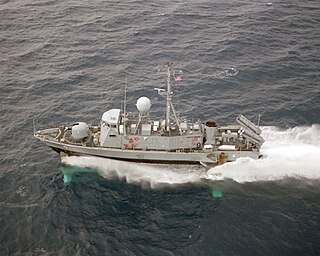
The Pegasus-class hydrofoils were a series of fast attack patrol boats employed by the U.S. Navy. They were in service from 1977 through 1993. These hydrofoils carried the designation "PHM" for "Patrol, Hydrofoil, Missile." The Pegasus class vessels were originally intended for NATO operations in the North Sea and Baltic Sea. Subsequently, participation by other NATO navies, including Germany and Italy, ceased and the U.S. Navy proceeded to procure six PHMs, which were highly successful in conducting coastal operations, such as narcotics interdiction and coastal patrol, in the Caribbean basin.

TurboJET is the brand name for the operations of the Hong Kong-headquartered Shun Tak-China Travel Ship Management Limited, which was established from the joint venture between Shun Tak Holdings Limited and China Travel International Investment Hong Kong Limited in July 1999. It operates hydrofoil ferry services between Hong Kong, Macau, Shenzhen and Zhuhai, in the Pearl River Delta area.
USS Delphinus has been the name of two ships of the United States Navy, named after Delphinus, a northern constellation.

HMCS Bras d'Or was a hydrofoil that served in the Canadian Forces from 1968 to 1971. During sea trials in 1969, the vessel exceeded 63 knots, making her the fastest unarmed warship in the world at the time.

USS Plainview (AGEH–1) was, in its time, the world's largest hydrofoil. Named for the cities of Plainview, New York and Plainview, Texas, she was also the United States Navy's first hydrofoil research ship. Plainview was laid down 8 May 1964 by the Lockheed Shipbuilding and Construction Company, Seattle, Washington; launched 28 June 1965; sponsored by Mrs. John T. Hayward; and placed in service on 3 March 1969.

The Sparviero-class are small hydrofoil missile boats capable of traveling at speeds of 46 knots. They were designed for and formerly used by the Italian Navy. The Japanese 1-go class missile boat is an updated version formerly used by the Japan Maritime Self-Defense Force (JMSDF).

The Matka class is the NATO reporting name for a group of hydrofoil missile boats built for the Soviet Navy. The Soviet designation is Project 206MR Vikhr.
The Sarancha class is the NATO reporting name for a hydrofoil missile boat built for the Soviet Navy. The Soviet designation was Project 1240 Uragan.

PHM Pegasus is a ship simulation and action game released for the Commodore 64, Apple II, Amstrad CPC, and ZX Spectrum. The title refers to the USS Pegasus (PHM-1), one of the Pegasus-class hydrofoils which were used by the U.S. Navy in the 1970s.
















